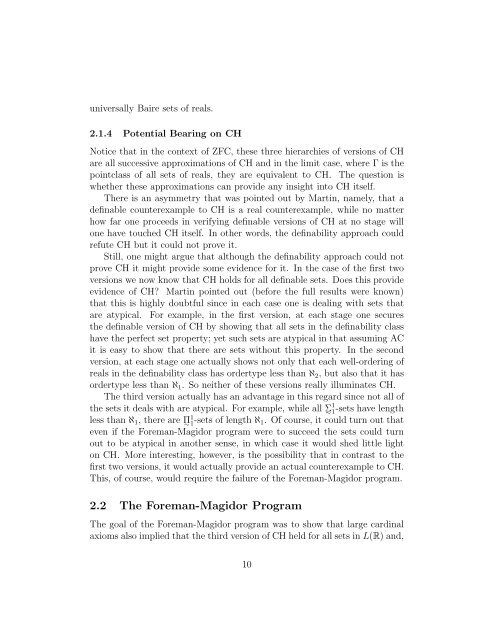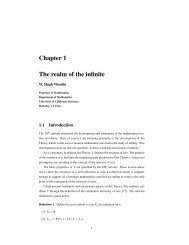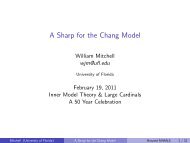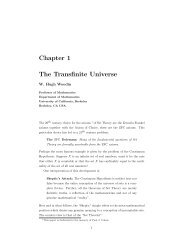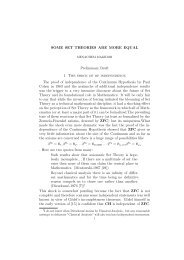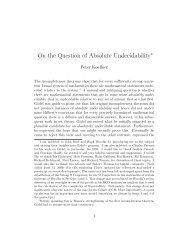The Continuum Hypothesis - Logic at Harvard
The Continuum Hypothesis - Logic at Harvard
The Continuum Hypothesis - Logic at Harvard
You also want an ePaper? Increase the reach of your titles
YUMPU automatically turns print PDFs into web optimized ePapers that Google loves.
universally Baire sets of reals.2.1.4 Potential Bearing on CHNotice th<strong>at</strong> in the context of ZFC, these three hierarchies of versions of CHare all successive approxim<strong>at</strong>ions of CH and in the limit case, where Γ is thepointclass of all sets of reals, they are equivalent to CH. <strong>The</strong> question iswhether these approxim<strong>at</strong>ions can provide any insight into CH itself.<strong>The</strong>re is an asymmetry th<strong>at</strong> was pointed out by Martin, namely, th<strong>at</strong> adefinable counterexample to CH is a real counterexample, while no m<strong>at</strong>terhow far one proceeds in verifying definable versions of CH <strong>at</strong> no stage willone have touched CH itself. In other words, the definability approach couldrefute CH but it could not prove it.Still, one might argue th<strong>at</strong> although the definability approach could notprove CH it might provide some evidence for it. In the case of the first twoversions we now know th<strong>at</strong> CH holds for all definable sets. Does this provideevidence of CH? Martin pointed out (before the full results were known)th<strong>at</strong> this is highly doubtful since in each case one is dealing with sets th<strong>at</strong>are <strong>at</strong>ypical. For example, in the first version, <strong>at</strong> each stage one securesthe definable version of CH by showing th<strong>at</strong> all sets in the definability classhave the perfect set property; yet such sets are <strong>at</strong>ypical in th<strong>at</strong> assuming ACit is easy to show th<strong>at</strong> there are sets without this property. In the secondversion, <strong>at</strong> each stage one actually shows not only th<strong>at</strong> each well-ordering ofreals in the definability class has ordertype less than ℵ 2 , but also th<strong>at</strong> it hasordertype less than ℵ 1 . So neither of these versions really illumin<strong>at</strong>es CH.<strong>The</strong> third version actually has an advantage in this regard since not all ofthe sets it deals with are <strong>at</strong>ypical. For example, while all Σ ∼11 -sets have lengthless than ℵ 1 , there are Π ∼11 -sets of length ℵ 1 . Of course, it could turn out th<strong>at</strong>even if the Foreman-Magidor program were to succeed the sets could turnout to be <strong>at</strong>ypical in another sense, in which case it would shed little lighton CH. More interesting, however, is the possibility th<strong>at</strong> in contrast to thefirst two versions, it would actually provide an actual counterexample to CH.This, of course, would require the failure of the Foreman-Magidor program.2.2 <strong>The</strong> Foreman-Magidor Program<strong>The</strong> goal of the Foreman-Magidor program was to show th<strong>at</strong> large cardinalaxioms also implied th<strong>at</strong> the third version of CH held for all sets in L(R) and,10


